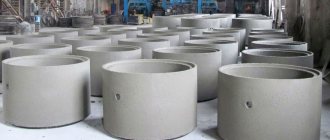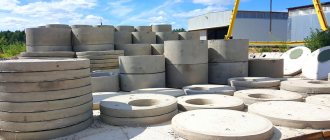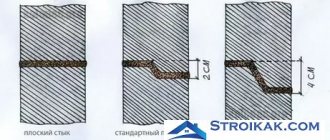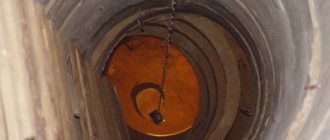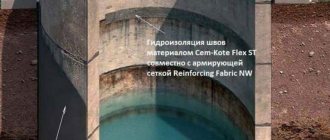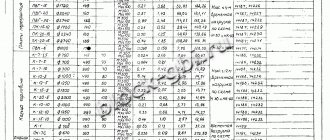This question often visits those who are involved in construction, repair or arrangement of suburban areas, but it also happens that the average person has to look for an answer to it. In our article we will try to help you with this, we will tell you not only about the formulas and calculations themselves, but we will talk a little about the concrete rings themselves.
The hole for the well is made after its final design
Let's figure out how to calculate the volume of a concrete ring for constructing a well on a site
This question often visits those who are involved in construction, repair or arrangement of suburban areas, but it also happens that the average person has to look for an answer to it. In our article we will try to help you with this, we will tell you not only about the formulas and calculations themselves, but we will talk a little about the concrete rings themselves.
The hole for the well is made after its final design
Reinforced concrete rings
Reinforced concrete rings are special structures for constructing wells of various sizes, which are most often used in external water supply and sewerage networks.
The production of standard products is carried out in factory conditions from high-quality concrete in strict compliance with GOST “Reinforced concrete plumbing structures”.
The process of producing concrete rings is not particularly difficult; for this you need:
- Reinforced steel with a diameter of up to 10 mm.
- High quality concrete.
- Casting mold.
Reinforced concrete products for constructing wells are produced in standard sizes with markings that reflect the purpose of the ring and its standard size. We will talk about the varieties below.
As for how the price of each specific product is calculated, it is necessary to understand how many cubes are in a concrete ring; in fact, the more, the higher the cost.
Calculation of reinforced concrete support ring
Knowing the size of the product, it is easy to calculate the volume of concrete in the reinforced concrete ring, which is necessary for its manufacture.
But since there are many different options on the construction market, take, for example, the support ring KO 6 - the volume of concrete of the product is calculated as follows:
- First, we need to write down the parameters (dimensions), in this case they will be equal to the following indicators - 840 x 580 x 70 mm.
- Let's calculate the area of a circle with a larger diameter using the formula - ¼ P d2 = 1/4 x 3.14 x (0.84 x 0.84) = 0.553896 m2. Where P = 3.14, and d is the outer diameter (in our case 840 mm). Let's convert everything into meters.
- Now, using the same formula, we calculate the area of a circle with an internal diameter - ¼ x 3.14 x (0.58 x 0.58) = 0.264074 m2.
- Let's find out the area of the product itself; to do this, we need to subtract the area with the inner diameter from the area of the circle with the outer diameter 0.553896 - 0.264074 = 0.289822 m2.
- By multiplying the area by the height, we find out its volume - 0.289822 x 0.07 = 0.02028754 m3.
So, we calculated the volume of concrete for the support ring KO 6, as you can see, there is nothing complicated about it, the main thing is to know the formula and parameters of the product. However, it is always easier to make calculations than to build a well with your own hands; special equipment is needed here.
At a minimum, a crane is required that can lift a load weighing half a ton or even a ton (pictured)
Types of reinforced concrete products for wells
We present the parameters of all types of manufactured rings for clarity (the parameters will be described in the following order - height, wall thickness, internal diameter and weight):
The figure shows important parameters that will help make calculations
Note! The KS marking means the following – wall ring.
- KS-7-1, 10 cm, 8 cm, 70 cm, 46 kg.
- KS-7-1.5; 15 cm, 8 cm, 70 cm, 68 kg.
- KS-7-3, 30 cm, 8 cm, 70 cm, 140 kg.
- KS-7-5, 50 cm, 8 cm, 70 cm, 230 kg.
- KS-7-6, 60 cm, 8 cm, 70 cm, 250 kg.
- KS-7-9, 90 cm, 8 cm, 70 cm, 410 kg.
Products with a small height are called additional
- KS-7-10, 100 cm, 8 cm, 70 cm, 457 kg.
- KS-10-5, 50 cm, 8 cm, 100 cm, 320 kg.
- KS-10-6, 60 cm, 8 cm, 100 cm, 340 kg.
- KS-10-9, 90 cm, 8 cm, 100 cm, 640 kg.
- KS-12-10, 100 cm, 8 cm, 120 cm, 1050 kg.
- KS-15-6, 60 cm, 9 cm, 150 cm, 900 kg.
- KS-15-9, 90 cm, 9 cm, 150 cm, 1350 kg.
- KS-20-6, 60 cm, 10 cm, 200 cm, 1550 kg.
- KS-20-9, 90 cm, 10 cm, 200 cm, 2300 kg.
A wide variety of rings allows you to easily equip a well of the desired size
Please note that products weighing more than 100 kilograms have reinforced ears.
A product marked, for example, KS-10-6 is called a complete wall ring with dimensions:
- Height-60 cm.
- Inner diameter - 100 cm.
There are products marked KO (support ring), these products are found in the following version:
- KO-6, height - 7 cm, internal diameter - 58 cm, external diameter - 84 cm, weight - 60 kg.
Another modification is a lining under the hatch of wells (ring K 1a the volume of concrete is calculated according to the following parameters):
- K - 1a, height -18 cm, internal diameter - 58 cm, external diameter - 100 cm, weight - 160 kg.
Marking PP means floor slab
Additional products allow you to more accurately regulate the height of the well, in some cases leveling it with the ground, in others making them more visible. Installing concrete lining elements on the well covering slab will help raise the hatch above its surface.
This eliminates:
- Flow of rain and melt water into the well.
- Vehicle collision with a manhole if the well is located under the roadway.
- Flooding of the hatch itself.
One of the important parameters of such a product is the volume of the concrete ring - 1 cubic meter, this is the unit of measurement for all such calculations.
Advice! You may often come across advertisements for the sale of used concrete products, including wall supports for a well; our advice to you is to study the product before buying. In particular, inspect the interior walls, where unevenness and different shades of concrete may be visible (this is how unscrupulous sellers seal cracks).
Conclusion
We hope that the above instructions will help you find the correct answer to the question posed. If any difficulties arise in this process, you can always use a free electronic calculator, which can be found on the Internet.
In the videos presented in this article you will find additional information on this topic.
masterabetona.ru
Questions and answers
Dimensions
What can be the diameter of the rings? The diameter of the well ring varies from 60 to 250 centimeters.
In the photo - KS-25-12. Diameter - 2.5 meters.
Let us clarify: we are talking about the internal diameter. The outer one is 16-24 centimeters larger due to the thickness of the walls.
The minimum height of the well ring is only 150 millimeters (for example, for KS-7-1.5). Maximum - 3.5 meters (KS-7-3). However, products with a height of 90 - 100 centimeters are in greatest demand.
What is the volume of water in the well ring? The volume of a cylinder is equal to the product of the square of its radius times the height and the number pi. Thus, for the most popular rings with an internal diameter of 1.5 meters and a height of 0.9 meters, the internal volume will be (0.75^2) x 0.9 x 3.1415 = 1.6 cubic meters.
To get the volume of the well ring in liters, just multiply this value by 1000: 1.6 x 1000 = 1600 liters.
Formula for calculating the volume of a cylinder. R is its radius, H is its height.
Kinds
Are these products always a regular thick-walled cylinder? Not at all.
In the price lists of manufacturers you can find the following varieties:
- - a product with a groove and a protrusion at the upper and lower ends, respectively. The design avoids lateral displacement of the well elements and significantly simplifies its sealing.
- Products with a bottom are designed for the installation of wells at high groundwater levels, when drainage through the floor can lead not to draining the well, but to filling it.
Note! Rings with a bottom are often used to construct cesspools and primary settling tanks in homemade septic tanks. However, for these purposes it is much better to use plastic containers or, in extreme cases, monolithic concrete structures. The instruction is related to the inevitable violation of the tightness of the seams over time and, as a result, contamination of the soil with untreated wastewater.
- The so-called additional ones are all products less than 40 centimeters high. They are used for non-standard height or depth of the structure being created (not a multiple of the height of one large ring).
- Perforated - having a large number of holes in the walls. Their purpose is to effectively drain treated wastewater into the ground. The scope of application is quite predictable: including local treatment facilities.
Note: when choosing reinforced concrete products, it is worth considering that sellers (not manufacturers, namely sellers) do not always understand the markings or distort them. Let's say, a well ring K 10 by 10 may well in the real world turn out to be both a KS-10-10 ring and a KCD-10-10ch ring, differing from the previous one by the presence of a bottom, a lock and a twofold difference in cost.
Price
How much does a well ring cost? Of course, the price depends on its size and shape.
Here are a few examples from a price list found on the World Wide Web.
- KS-7-6 (diameter 70, height 60, regular wall ring) - 850 rubles.
- KS-20-9 (200x90 cm) - 4500 rubles.
- KS-15-10h (150x100 cm, with lock) - 3,750 rubles.
- KCD-15-9 (150x90, with bottom) - 4650 rubles.
- KCD-20-10ch (200x100 cm, with bottom and lock) - 18,000 rubles.
For many types of communications, not only pipes, but also reinforced concrete rings are often used. Today we will be interested in those types that are used to install autonomous sewage systems. Previously, when rings were inaccessible to the average developer, the sewer well was either filled with concrete over formwork or lined with brick. Naturally, this took a lot of time, money and cost a lot of effort. Sewer rings have become available and with their help you can complete a turnkey septic tank, down to the very last element, including the manhole cover.
Ring volume: 7 advantages of reinforced concrete
You should choose a concrete ring depending on the purposes for which it will be used. A properly equipped sewage system is the key to complete comfort. Even in a small summer cottage, you can enjoy all the benefits of civilization by equipping a cesspool made of concrete rings of different diameters on the site.
Content:
Reinforced concrete rings are widely used for the construction of sewer systems - inspection wells or cesspools. The use of rings is considered the simplest and most convenient way to arrange a sewerage system.
The rings are made of reinforcement and concrete, they are very durable and are used primarily for durable work.
When choosing rings for a cesspool, you should consider the number of people living in the house
A sewer system equipped with reinforced concrete rings is reliably protected from various weather conditions and protects groundwater from sewage leakage.
There are two types of rings - Euro rings with a lock and ordinary reinforced concrete rings. The second type of rings is connected to each other with cement mortar and iron staples.
Advantages of using reinforced concrete rings:
- Long product life;
- Resistant to loads;
- Do not allow moisture to pass through;
- Easy installation and operation;
- Low cost;
- Can be used to equip sewerage systems, small tunnels, power lines and heating networks;
- Protect from groundwater.
The disadvantages include purely technical aspects - the heavy weight of reinforced concrete rings requires transportation in a large car, and their installation is only possible using special equipment.
Classification and volume of reinforced concrete rings
These rings are made of heavy concrete B25, frost resistance of which is F-100, water permeability of W4. Reinforced concrete rings are marked, according to which the classification of the ring can be determined.
Reinforced concrete rings are divided into prefabricated, additional, with a lid, with a lock and with a bottom.
First, the marking indicates the type of structure: KS - wall ring, KSD - wall ring with a bottom. After the type, the size of the ring is written, the first group of numbers indicates the diameter of the ring, after the hyphen - the height of the product. For example, KS-15 designates a wall ring with a diameter of 1500 cm.
Before purchasing reinforced concrete rings, you need to check them for cracks.
When installing a cesspool on a site, first of all, the size of future sewage is taken into account. Depending on the depth of the sewage pit, the required number of reinforced concrete rings and their types are calculated.
The standard height of the rings is 90 cm, but if necessary, the design can be supplemented with rings of other sizes. Depending on the needs, the diameter is selected - from 70 to 200 cm. The thickness of the concrete wall is 7-14 cm.
The strength of the structure largely depends on the bottom well ring - experts recommend installing a ring with a bottom. Next come the wall rings and the cesspool is closed with a lid with a hatch. The diameter of the septic tank elements must be the same everywhere, otherwise the structure will be unstable and sewage may leak into the ground.
The volume of a concrete ring is 1 meter: the nuances of building septic tanks
A single-chamber septic tank made of reinforced concrete rings must have a bottom and a lid. Such a cesspool is considered ineffective; it is most often installed in the country.
A drainage pit is installed at a distance of no more than 20 m from a residential building. The further away the septic tank is, the more pipes will have to be laid from the sewer system in the house to the reinforced concrete septic tank. In this case, the minimum distance to residential buildings is 5 m. When installing a septic tank, you should take into account the number of people who will use the sewerage system. On average, a person uses approximately 200 liters of water per day for sewage.
When choosing rings made of reinforced concrete, it is important to know how many liters of waste water this structure can accommodate. It is believed that the minimum volume of a septic tank made of rings is 6 cubic meters. To calculate the volume of a reinforced concrete ring, you need to multiply the number of residents by 200 liters, and multiply the resulting amount by 3 (the period of time during which the wastewater is processed in the pit). To obtain the volume of the ring, divide the final amount by 1000. Based on the tables on the Internet, select a reinforced concrete ring with a suitable diameter. One standard 90 x 150 cm ring holds approximately 1.59 liters of water or waste.
It is best to dig a hole for concrete rings using an excavator
When installing a septic tank from rings, you need to remember that the surface on which the rings are placed must be strictly horizontal.
If it is not possible to install a lower ring with a bottom, you can fill it with a dense layer of crushed stone and fill it with cement mortar. The top of the septic tank is covered with a ring with a hermetically sealed cast-iron sewer hatch.
Cesspool made of concrete rings without a bottom: do-it-yourself installation
Before you start laying the rings, you need to prepare a pit 3 meters deep for the cesspool. Its width should be slightly larger than the diameter of the reinforced concrete rings selected for the septic tank.
You can dig a hole for a foundation pit yourself using shovels, or you can hire special equipment to get the job done faster.
The bottom of the pit must be leveled with sand, on top of which a concrete ring with a bottom or an ordinary wall ring is installed.
A cesspool without a bottom can be installed in places where there is no groundwater
How to install a septic tank from reinforced concrete rings:
- Install the first ring. Check that it does not lean to the side.
- Having installed the next wall ring, fill the space between the septic tank and the pit.
- Gradually build a septic tank, not forgetting to check the level of installed reinforced concrete rings.
- Seal the joints between the rings with a solution of cement and sand.
- Using a hammer drill or grinder, make holes for the sewer pipes. The drain pipe from the house is installed at a slight angle.
- If the sewerage system consists of several septic tanks, in addition to the drainage pipe, you need to lay a pipe connecting the septic tanks. This pipe is located 20-30 cm below the waste pipe.
- To prevent runoff from getting into the ground, it is important to choose the right waterproofing. For this, bitumen or polymer mastic is used.
- The final stage is installing covers on the septic tank. After the joints have dried, you can begin using the cesspool.
A septic tank made of reinforced concrete rings does not require special operating rules, but it is important to clean it on time and use special bacteria to better process wastewater.
How to calculate the volume of a ring (video)
The performance of a reinforced concrete septic tank largely depends on the quality of the materials from which it is made. All items must be correctly labeled. By observing all the nuances and installation technologies, the waste pit will last for quite a long time.
homeli.ru
Standard requirements
GOST 8020-90 regulates the production of all structures made of heavy (that is, not porous in any way) concrete with and without reinforcement, used for the construction of round wells for the following purposes:
- Sewer (inspection, cleaning, collector, etc.)
- Gas pipelines (of course, where the gas pipeline runs underground).
- Plumbing. This includes wells for draining cold water to a private house, intended for installing shut-off valves on the highway, wells for fire hydrants and many others.
- Storm sewer wells.
It is curious: the standard does not provide for the use of structures for centralized heating inlets, construction of water intake wells, septic tanks and cesspools. However, in practice, such universal products, of course, are used much more widely than provided for in the regulatory document.
Let's go over the most interesting points of the standard.
- The product labeling indicates its purpose and main dimensions. Thus, KS-25-12 is a wall ring (intended for the working chamber or well neck) with a diameter of 2.5 meters and a height of 1.19 meters (the marking rounds the actual values to the nearest round number).
- Reinforcement, if present, must be completely hidden by concrete to avoid accelerated corrosion. At the same time, the types of fittings are strictly regulated.
- If the design of the ring provides for the presence of running brackets, their width is taken to be 30 cm, depth - at least 12 cm. The brackets are protected from corrosion by a paint coating.
- Rings can be stored in no more than two rows vertically. Bottoms and floor slabs - no more than six rows, with the obligatory laying of gaskets with a thickness exceeding the height of the mounting loops.
Volume of reinforced concrete rings
Reinforced concrete rings are most often made when developing land plots. Often, owners of suburban areas have to make a ring with their own hands. To do this, you need to know the formulas used for calculations and the features of concrete products. Products manufactured for the well are labeled in accordance with the requirements of state standards. Markings are symbols indicated on the rings by which information about the size and weight of materials can be identified.
For each concrete product produced in accordance with the requirements of state standards, tests are provided that confirm the quality, declared performance characteristics and resistance of the product to negative factors. When summing up, experts take into account water resistance, frost resistance, moisture absorption, and compressive strength.
Reinforced concrete rings
Reinforced concrete rings are special products designed for constructing wells used in water supply systems, as well as for water drainage. The easiest way is to entrust the work on the sewer system of a private house to one of the companies. However, it is necessary to calculate in advance how much money will be spent on this. If you want to save money, you can make a sewer system, which will be based on a concrete ring, yourself. The production of such products is carried out at enterprises in compliance with state standards. When creating, high-quality materials are used, CCD. The manufacture of products involves the use of a special form, concrete and reinforcement, the diameter of which should not exceed ten millimeters.
Reinforced concrete building materials of this type are marked with markings that determine their purpose and standard size. If we talk about how to calculate the cost of a particular product, it is important to take into account the volume of the rings. The higher this indicator, the more expensive the material.
Types of well parts
Well bottoms KCD 10a.
Well bottoms KCD 10a are a necessary part of a prefabricated septic tank. The durability of the product depends on the quality of their manufacture and correct installation. The bottom of KCD 10a is produced in the form of a monolithic reinforced concrete slab with several special hinges. Bottoms of different diameters are available for sale. Donyshko KCD 10a is produced according to the approved standard. The dimensions of the CCD are designed so that the bottom can withstand the load of liquid that accumulates in the container. In doing so, manufacturers take into account possible soil mobility and the impact of groundwater. KCDs are selected according to the diameter of other well parts - KC rings, covers, etc.
Examples of parameters of several types of CC rings (height and weight of CC products):
- KS-7-1; ten centimeters, forty-six kilograms;
- KS-7-1.5; fifteen centimeters, sixty-eight kilograms;
- KS-7-3; thirty centimeters, one hundred and forty kilograms;
- KS-7-5; fifty centimeters, two hundred and thirty kilograms.
Materials KS, KTs, whose weight exceeds one hundred kilograms, must have special ears. A product that is marked, for example, KS10-6, is called a wall product. On sale you can also see materials with the designation KO6 (support ring). Products marked KO6 have a height of seven centimeters, an internal diameter of fifty-eight cm, ext. diameter - eighty-four cm, weight - sixty kg. K06 support products are also used when carrying out work on sites.
Concrete CCs (KO6, KS10) allow you to more accurately determine the height of the container. You can level it with the surface of the ground or make sure that the rings are above the soil level. Installing concrete parts on a special slab will allow you to raise the well hatch. Due to this, it will be possible to prevent the ingress of melt and rain water and flooding of the hatch. The volumes of the rings are important when carrying out calculations for CC. The cubic meter is the basic unit of measurement.
Calculation of a reinforced concrete support element
Parameters for calculating the volume of concrete rings.
To determine the parameters for the manufacture of well elements and other parts made of reinforced concrete, it is necessary to first calculate the cost of their production. To carry out calculations, you will need initial data: an indicator of the volume of concrete mixture to create rings, a well bottom, and a lid; total consumption of reinforcement and the amount of reinforcing mesh for each element. The consumption of concrete solution for a well ring is determined as follows:
- First of all, you should write down the parameters.
- Then calculate the area of the circle (outer diameter). To do this, use the calculation formula (¼ P d2). P stands for 3.14, d – adv. diameter. It is necessary to convert the numbers into meter values.
- After this, using the above formula, calculate the area of the circle (inner diameter).
- The area of the concrete product is determined as follows: from the value of the area of the circle with the floor. diameter subtract the area of the circle from the inside. diameter
- To determine the volume, you need to multiply the height and area.
If you have difficulty counting, you can resort to using a calculator.
Conclusion
Septic tanks, tunnels, systems for draining liquids are the main construction projects for the installation of which concrete rings are used. These elements have become widespread in the field of constructing well containers for various purposes.
kladembeton.ru
Classification and design
By design, sewer rings can be of three types:
- Sewer rings with locking connections. Such products are cast with a protrusion in the upper part and a groove along the perimeter of the ring in the lower part. When installing a prefabricated reinforced concrete structure of a septic tank or well, the rings are connected with a locking connection. At the same time, they are guaranteed to maintain their original position and tightness.
- Reinforced concrete rings are straight. They do not have a locking connection, therefore, when installing the structure, they must be fixed with metal brackets and sealed with concrete mortar.
- Filtration rings. The ring has perforations over the entire surface area, consisting of equal and equidistant holes. Such elements of prefabricated reinforced concrete structures are used in filtration-type sewer wells.
These are the main types of rings, but there are also products of smaller height. These can be adjusting rings and additional elements that allow you to bring the height of the well to the required level relative to the ground. There are also rings with a thicker wall and a smaller diameter, which allows you to adjust the volume of the well. The additional element completely matches the internal diameter of the main ring and allows you to install the inspection hatch at the required level.
Cesspool made of concrete rings: how to build a two-chamber sump
A cesspool without a bottom is the simplest sewerage structure suitable for any country house. Even the greenest novice builder can make such a device. However, a two-chamber cesspool made of concrete rings, the creation of which is not much more difficult, solves the problem of wastewater disposal somewhat more effectively.
The principle of the design and operation of this design
For lining the walls of a regular cesspool without a bottom, ready-made concrete rings are perfect. You just need to lower them to the bottom, and then seal the seams and carry out waterproofing work. This is easier than concreting the walls of a cesspool or laying bricks. Such sewerage devices are ideal for a summer house, which is used only in the summer, on weekends and on holidays. If the volume of wastewater exceeds a cubic meter per day, it is worth considering the construction of a two-chamber device.
In this case, the volume of work will at least double, since you will actually have to dig two holes, concrete the bottom of one of them, arrange drainage in the other, etc.
As a result, the efficiency of wastewater processing will increase several times. First, human waste will fall into the first pit, the bottom of which is carefully concreted. In this compartment, solid particles will settle to the bottom, slowly being processed through the fermentation process and turning into sludge. This part of the cesspool made of concrete rings must be cleaned periodically.
Tip: To improve the processing of solid waste, cultures of special anaerobic bacteria are added to the settling tank. It must be remembered that such organisms cannot tolerate the presence of chlorine-containing components in water.
The sump is connected by an inclined pipe to the second compartment of the cesspool, which is a drainage well. The bottom of this pit is not concreted, but covered with a layer of drainage. Wastewater, partially purified in the first compartment, undergoes natural post-treatment and enters the ground. Such a cesspool requires the services of sewage trucks much less often than a regular one, and the likelihood of soil contamination with wastewater is significantly reduced.
A few words about concrete rings
Typical concrete rings for a cesspool are also convenient because you can easily calculate the volume of the future septic tank by multiplying the circumference of the ring by its height. The first number indicated when marking a concrete product means the diameter of the ring in decimeters, and the second – its height.
For example:
- KS-10.9 is a ring with a diameter of 1 meter and a height of 90 cm. Its volume is 0.71 cubic meters. m.;
- KS-15.9 is a ring with a diameter of 1.5 meters and a height of 90 cm. Its volume is 1.59 cubic meters. m.;
KS-20.9 is a ring with a diameter of 2 meters and a height of 90 cm. Its volume is 2.83 cubic meters. m.
Holes for sewer pipes in a concrete ring can be made with a hammer drill.
In addition to concrete rings, you should purchase a ceiling, since the cesspool must be securely closed. For a two-chamber septic tank you will need two ceilings. When making them, a round hole is made to provide access for cleaning. Close the hole with a special hatch, which should also be purchased.
Carrying out installation work
Before starting construction work, you should draw up a detailed plan and select a suitable location. In addition to the desire to preserve the aesthetic appearance of the landscape, it should be taken into account that the cesspool should be located:
- no less than five meters from a residential building;
- no less than 30 meters from a source of drinking water;
- in a place accessible for the entry of special transport of sewer trucks.
Please note: When choosing a suitable location for a cesspool, you should take into account not only the location of your own house, well or well, you must ensure that the sewerage system is located at a sufficient distance from neighboring buildings and structures.
To make a two-chamber cesspool from concrete rings, you must:
- Dig two pits in a suitable place (sometimes one spacious pit is enough).
- Concrete the bottom of the pit in which the sump will be built. After drying, cracks almost inevitably form in the concrete, which must be repaired to ensure sufficient tightness. This stage will take about a week or a little more.
Tip: To avoid concreting the bottom of the pit, you should buy a concrete ring, the bottom of which is already constructed.
- Install concrete rings in the hole.
Carry out thorough sealing of seams and waterproofing of the structure, for example, using cement mortar and liquid glass, bitumen, etc.
Concrete rings should be lowered into the pit carefully so as not to damage the structure. The joints of the concrete rings must be carefully sealed and treated with a layer of waterproofing.
- Install concrete rings at the bottom of the second pit.
- Place a layer of drainage on the bottom: crushed stone, broken brick, etc.
- Lay sewer pipes that are connected to the house, as well as connecting the cesspool compartments to each other.
Tip: The slope at which sewer pipes are laid should be approximately 2-3%, and the depth of the trench should be at least 80 cm to prevent freezing of the structure in winter.
- Check the tightness of the structure and correct any deficiencies identified.
- Install ceilings with a hatch and a ventilation hole above each cesspool compartment.
- Backfill the structure with soil.
A cesspool of this type is much more convenient than a regular one; the increased costs of its construction will soon pay off.
aqua-rmnt.com
Life hack: determine the size using your fingers
The method is suitable for those who do not know how to discreetly pick up a ring for a girl without knowing the size of her ring finger. This secret method is often used by guys who are planning to propose to their beloved. Ask her for one of the rings, “just try it on.” Place the jewelry on your finger and remember where the ring fits most comfortably. While your memory is fresh, run to the jeweler and ask him to measure the diameter of the marked area. Done, you are amazing!
Finding your ring size using your fingers
Keep in mind that on average, the smallest ring size for women is 14, and the largest is 22. Therefore, if your value suddenly turns out to be much smaller or larger, perhaps you made a mistake somewhere - try to calculate the required diameter again.
Bonus - table for determining the size of jewelry rings by finger circumference
If you want to order a ring abroad, the ring size chart will be very useful for you. Please note that all measurements are in millimeters (mm) rather than centimeters (cm). Using one of the indicated methods, measure the circumference of your finger and correlate the result with one of the points in this table:
Jewelry Ring Size Chart
That's all. We hope our tips were useful to you and you will not go wrong with the size of your gift ring. We wish you good luck in this important matter!
Author: Alexandra Tsiklauri

